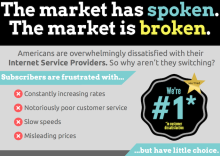Press Release: Tennessee Sends Broadband Accessibility Act of 2017 to Gov. Haslam's Desk
Tennessee Legislature Passes Broadband Accessibility Act, Delivers Hollow "Victory"
While Governor Haslam's Signature Legislation Sounds Great, AT&T Will Be Laughing all the Way to the Bank
Contact:
Christopher Mitchell
MINNEAPOLIS, MN - Late yesterday, the Tennessee Legislature officially sent Governor Bill Haslam's signature legislation, the Broadband Accessibility Act of 2017, to his desk. Unfortunately, this bill is more about making taxpayer dollars accessible to AT&T than ensuring rural regions get modern Internet access.
"What we have on one side is a taxpayer-funded subsidy program, and on the other we have a subscriber-based model," says Christopher Mitchell, director of the Community Broadband Networks initiative at the Institute for Local Self-Reliance. "The tragic thing is, AT&T is a taxpayer subsidized monopoly in rural Tennessee that only has to provide a service far slower than the definition of broadband. Locally-rooted networks like Chattanooga's EPB not only offer nation-leading services but have tremendous community support."
With this bill's passage, the Tennessee General Assembly will likely not pass any other broadband legislation during this session. The Broadband Accessibility Act won't improve Tennessee's rating as 29th in Internet connectivity, but it will do a great job of lining AT&T's pockets. As we've tracked throughout the session, there are a number of bills worth supporting that would actually increase connectivity and allow municipalities to take part in their own broadband future.




